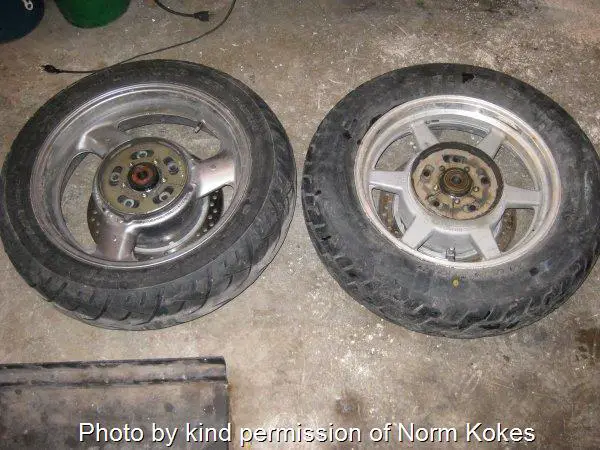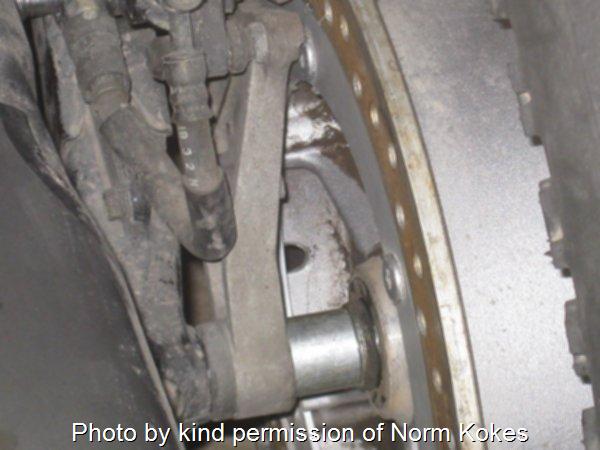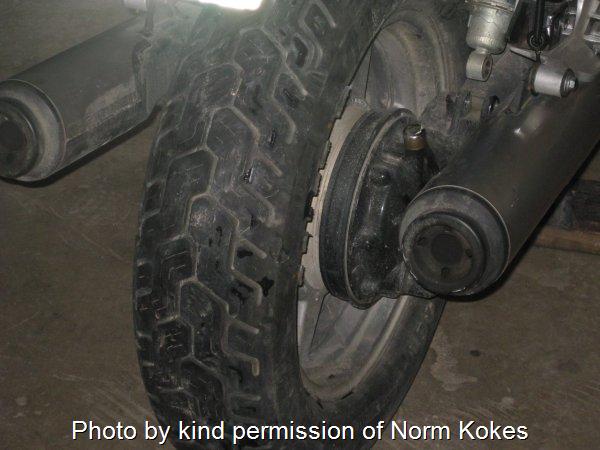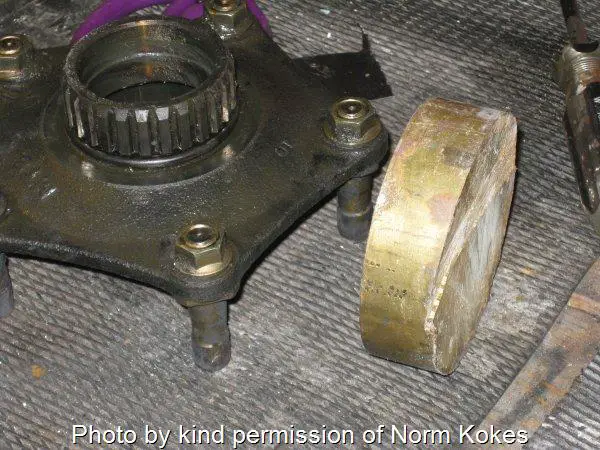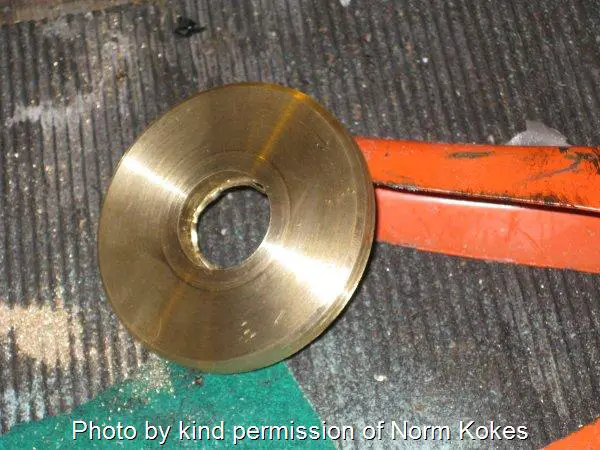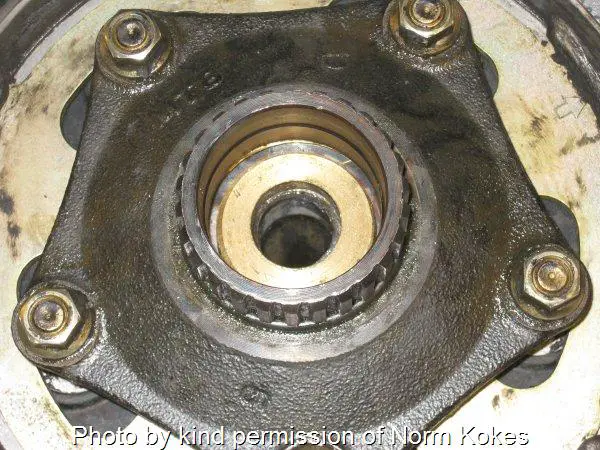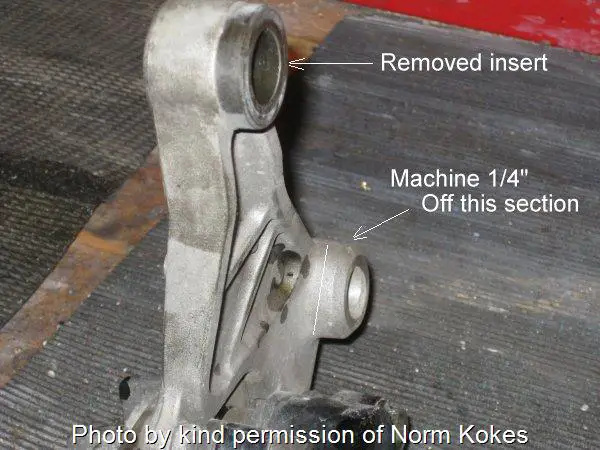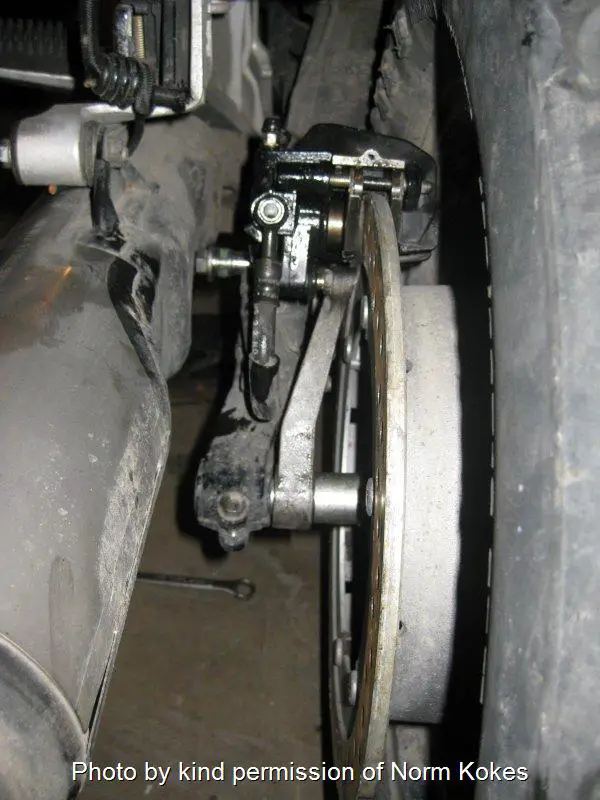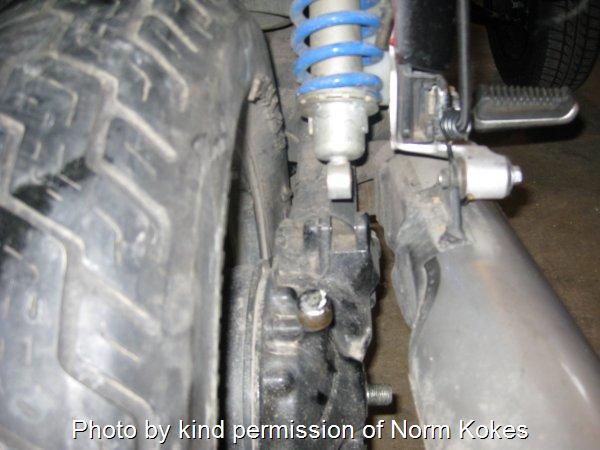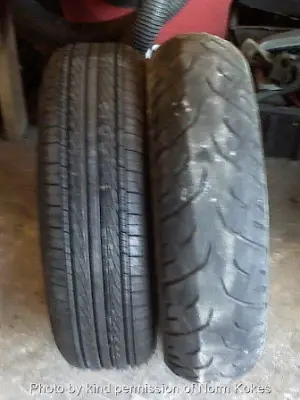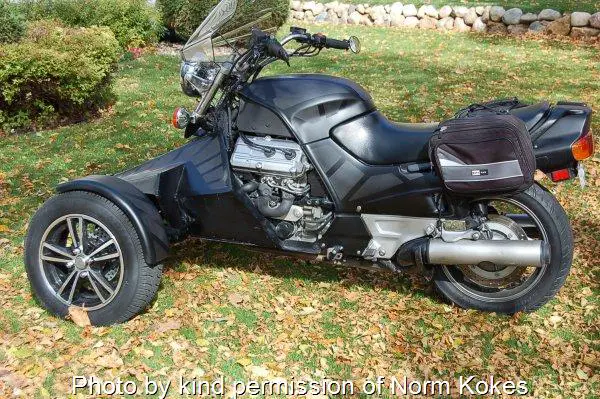Hmm. Fitting a car tyre to the ST1100 rear wheel? Why?! Well, the car tyre will last longer, and it's cheaper. And if you're doing a lot of mileage, it makes sense.
What about the footprint? You can't ride on the sidewall when cornering! Quite right, you can't. And you don't. The easiest way to show this is with the following two videos (they're of a Honda Valkyrie but they compare just how much tread is on the road, especially when cornering). The first shows a motorcycle tyre; the second, a car tyre (in my view this car tyre is slightly over-inflated):
Fitting a car tyre to a motorcycle is certainly controversial. Am I suggesting you do this? No. All I'm saying is that it's possible. It's known as going over to the Dark Side.
I initially struggled in researching this. My flawed reasoning went as follows: ST1100 rear tyre is on a 17" rim. Search for car tyres to fit a 17" rim.
The bottom line is - there is no useable car tyre for a 17" rim.
But with a slightly different approach...
Find a supplier of Goldwing motorcycle parts, and obtain a GL1500 rear wheel. It's a 16" rim. The drive coupling, brake rotor and calipers are identical to the ST1100. The wheel is, however, 1" narrower than the ST1100 wheel, so you need a 1" axle spacer.
ST1100 rear wheel on the left; GL1500 rear wheel on the right.
The 1" spacer. Photo shows original caliper, support bracket, and brake rotor.
The GL1500 rim (16") fitted to the ST1100.
Now in order for a car tyre to fit in the swing arm, the wheel needs to be shifted to the left. A 1/4" thick spacer needs to be made. The following photo shows the piece of brass stock prior to machining:
Once the spacer was at the required diameter a raised portion was added to compensate for the stock spacer that is part of the final drive assembly:
The brass spacer is then cut into two pieces; the inner part does not rotate, being fixed to the drive axle. The outer part with the drive hub rotates with the wheel.
With the wheel now shifted to the left, the caliper bracket needs to be modified accordingly. The hard steel axle bushing insert was removed and the locking nub reduced by 1/4":
(Note: it may be worth obtaining a second-hand caliper bracket and modifying that instead of the original. That way, if you ever want to revert to a normal motorcycle tyre, all you need to do is reinstall the original caliper bracket.)
Left side view - there is 3/4" space between the wheel and the swing arm tube:
Right side view - 1/2" space between the wheel and the swing arm tube:
Finally a comparison between the wheels. On the left, the car tyre on the GL1500 rim; a Formoza 175/60R16 steel belted radial. On the right, a very worn ST1100 tyre. The car tyre is about 1" to 1-1/4" smaller in diameter, resulting in the bike being lowered by about 3/4".
The above engineering was carried out in order to make a reverse ST1100 trike:
Norm kindly contacted me with further details regarding running a car tyre on a motorcycle:
I first ran a car tire on my 1961 Triumph Bonneville back in 1971. Back then we would put on 16" rims and run a 4x4x16 bias ply 2ply truck tire at 10-15 psi to soak up bumps as we also had chopper style ridged frames. Running regular tires meant also having to wear a kidney belt as the ride was rough as heck.
I was 20 at the time and couldn't care less about safety and cornering etc. as the main concern was building a cool looking bike. I worked at the local HD shop as a mechanic so I also had access to lots of tools and parts.
As time moved on and I went from one bike to another (over 60 to date) I pretty much stuck with bias ply motorcycle tires as the rims were 17 and 18 inch which are not suited well for car tires.
When I made the move to large tour bikes in 2003 I found the rear rim was not only 16" but also 5.5 inches wide. These large rims also include spacious swing arms and fenders so a 195x55x16 or 205x60x16 radial car tire fit just great. I now run a car tire full time on my 2001 GL1800 and run three car tires on my 1999 Valkyrie Reverse trike conversion along with the ST1100 RT conversion.
There is a lot of information regarding car tires on various boards however one must assume most of the info is perhaps unreliable. For one thing most Darksiders seem to be compelled to run the Run Flat tires. This in my opinion is mistake #1. Run-flat tires are very stiff and will actually stay ridged even with no air. This is why most car shops discourage people from running them on cars as the ride is not very smooth. The other mistake is running way too much air pressure. This not only hurts the ride but has an effect on handling.
The most common question one hears regarding car tires on motorcycles is "How can it corner when it's square?" This is an excellent question and if you go to YouTube and check out the various videos regarding car tires on motorcycles you will clearly see bikes cornering on the edges of tires. Most of these people are running 35-45psi so the tires are solid square blocks. Study the videos and you will see the poor logic. *
This does not mean a car tire will not work, it just means most people do not understand the physics. The best way to explain is this - take a look at an inline skater, as the skater goes around a bend his ankle is rigid and his body leans pivoting on a single contact area. Now put standard roller skates on this same person - he can still corner but now his ankle is the pivot point while all four wheels stay planted on the surface.
A car tire properly set up does exactly this. Running lower pressures (22-26psi) the sidewalls now flex in corners acting as the skaters' ankles, allowing a smooth transition while cornering.
The advantage to doing it right is, better smoother ride, and transparent cornering as now you're not teetering on the tire corners while making turns. And you can assume 40k or better vs. the 12-18k most Darksiders experience. Air pressure is one of this things where "feels mushy" is a mental experience so one must use logic and realize all the pressure does on tour bikes is hold up the load much like on your car. Do you run 44psi in your car tires? A GL1800 per tire weight is about half that of a standard car so why run twice as much pressure?
There is a downside to all this obviously. What I am talking about here is tour bikes, 900lb Goldwing's with a max lean angle of 40 degrees or so fully loaded with riders and gear going down the road like Goldwingers do.
While this tire type works even in spirited riding I don't believe it is a perfect fit for high speed aggressive type riding. Set up properly for tour type riding the sidewalls may flex a bit too much for "sportbiking".
Personally if I had a standard ST1100 or ST1300 I would definitely run a car tire mainly due to where I live and my riding style. Minnesota has some nice sweepers and even tight areas but not like SC or the Rockies. Around here a car tire would work fine even running in the "speeding ticket zone" for extended periods.
The conversion from a 17" rim to 16" is easy as Honda uses universal couplings and parts on their bikes (all Honda oil filters fit all Honda bikes for instance). This is mostly true for other things like brake rotors and rear wheel attachments. There is some machine work involved but most can be done with the aid of a grinder and hacksaw. After looking at the setup again the spacer may not be needed and the wheel may simply be installed without this modification.
The wheel diameter is going to be smaller so the bike will sit lower and rpm's will rise slightly. 26psi seems about right for this narrow tire so that's a good place to start. Just remember more air means shorter life and harsher ride. These tires are safe down to 4psi and I run 15psi on the front tires of both RT's as any more and they wear in the centers and bounce off the ground - not good in a rough corner.
My GL1800 has 32k on the rear tire now and I fully expect another 8-10k before it's done.
Running car tires on motorcycles is nothing new - as they have been used since 1903 - nor is it anything drastic, even doing everything wrong - too much air, run flat tires etc. - they still will work fine and you will be surprised at how transparent it becomes once you get past the "mental" awareness.
If you make the change keep in mind the #1 thing - 99% of what you feel or think is just mental, it's the mind thinking the tire or handling is something but in reality it's not. This is the absolute hardest thing to get around as the mind will force you to believe things that are imaginary not real.
As far as grip is concerned, there is a classic "feels like". How does one test grip? If you crash then there's poor grip; if not then it's good. I have yet to hear of anyone crashing on a car tire due to loss of grip however just like the rest it's a guess or feeling one pictures in the mind.
Loss of grip in a corner is usually not the tire but the road surface, oil, sand, antifreeze or animal blood etc. It doesn't make any difference what kind of tire you're running, if you hit sand you're going down.
(* see videos at the top of the page)
Norm's website can be found here.
What about fitting a car tyre to the front wheel? In a word, no. The front tyre's profile assists in cornering - if you had a car tyre on there you would find it very difficult indeed to turn.
I concur with Norm's view regarding grip in corners. I've twice come off the ST1100; once in turning into a side road slightly too aggressively in the rain - the rear wheel went over the painted white line, and - sllllliiiiiip!
The second time (again in the rain) I ran over a manhole cover whilst in a curve. This time it was the front wheel which slipped out. And there's no time to do anything except bounce. In both cases my tyre pressures and treads were fine. (And both times I was fortunately not going very fast!)

